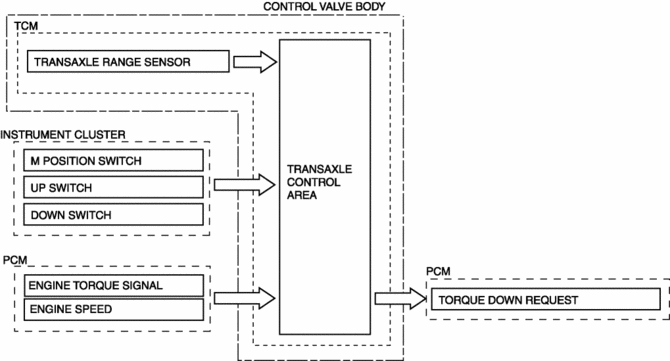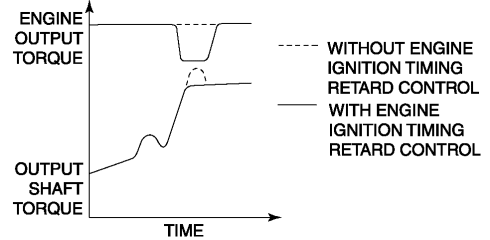Mazda CX-5 Service & Repair Manual: Engine Transaxle Integration Control [Fw6 A EL, Fw6 Ax EL]
Outline
-
The TCM controls engine output torque and reduces transaxle output shaft torque fluctuation during auto shifting, and reduces shock occurring from the vehicle during shifting.
Construction

Operation
-
During auto shifting, the TCM sends the torque reduction request signal using the CAN system and temporarily reduces the engine output torque by the engine ignition timing retard control. As a result, transaxle output shaft torque fluctuation is reduced during auto shifting by smooth engagement of the clutch.

-
In addition, the TCM receives the engine output torque from the PCM via the CAN signal to determine the clutch engagement pressure according to the engine output torque. As a result, the clutch hydraulic control setting accuracy is increased and smooth shift performance is achieved.
 Engine SST
Engine SST
1: Mazda SST number
2: Global SST number
Example
1:49 UN20 5072
2:205–072
Holder
1:–
2:AKS042808
Adapter
...
 Engine Tune Up
Engine Tune Up
Engine Tune-up Preparation
NOTE:
If the accelerator pedal is depressed continuously for a specified time,
the engine speed may decrease to the idle speed. This is due to the fuel cut
co ...
Other materials:
Main Fuse
Purpose
If electric current of the specified value or more flows to each fuse, the
fuse melts due to heat generation to protect the systems and parts downstream
of the fuse.
Function
If electric current to each fuse is the specified value or more, the fuse
melts due to h ...
Exhaust System
Purpose, Outline
A 4-2-1 exhaust system has been adopted which reduces residual gas in the
cylinders using the scavenging effect and contributes to a high compression
ratio.
The loop structure of the exhaust pipes for the 4-2-1 system takes up less
space.
Structural Vie ...
Awd Control Module
Purpose, Function
The AWD CM calculates the optimal amount of torque distribution for the rear
wheels and outputs a corresponding electric current to the electronic control
coupling (AWD solenoid). This calculation is based on the accelerator pedal
angle, four-wheel speed, engine spe ...
